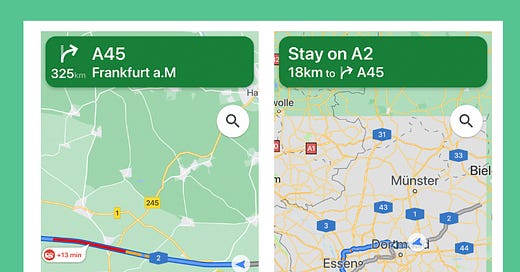What AI features are incorporated into Google Maps? More than you might think! Google is working on improving a whole portfolio of AI features when it comes to their Google Maps product, one of the most sophisticated mapping systems in the world, with vast amounts of data mapping literally every inch (or almost every inch) of this world.
Google Maps has invested heavily into AI summaries of a variety of locations, from coffee shops to restaurants to national parks, museums, hiking trails, and scenic spots. These summaries are also available in search results, different locations prioritized by AI depending on the search.
AI is also heavily being used to plan routes and actually “see” places before you get there via 3D immersive views of a variety of locations. But while all this fancy AI tech is great and continues to be splashed across news headlines on a regular basis, is it actually helping?
Is Google Maps actually a better experience because of AI? Hmm, for us the answer is yes and no. AI features in Google Maps have a lot of potential to make our lives easier, but sometimes they miss the mark.
What’s an example of ‘good’ Google Maps AI? We think it’s pretty great that Google Maps can analyze our routes in real-time and make suggestions to switch to a faster route depending on traffic patterns. Google will usually interrupt your drive to ask you if you want to switch to the faster route, giving you a few seconds to make the switch while trying to minimize notifications and interruptions while you drive.
What’s an example of ‘bad’ or ‘could be improved’ Google Maps AI? We think that the Google AI search recommendations could be improved. Google can rely on a vast data set of locations all over the world to help us discover new places…however, that recommendation system doesn’t seem to understand what we want as humans.
This is where user research, UX strategy, and product strategy are crucial so that we can understand user perspectives and provide them with the best types of recommendations. We tend to be in different moods when we travel- sometimes we just want to get to our destination fast. Other times we want to explore local restaurants. And other times we want to sightsee as we stroll about aimlessly within a city.
When I was in Rome, I used Google Maps to go from monument to monument, sightseeing by choosing my own way and wandering about the city for hours. I got annoyed whenever Google recommended that I stop at a commercial store in between sights. I really was not in the mood to shop, and the algorithm should have understood this via my searches.
In this way, Google Maps was trying to prioritize consumerism, spending, and advertising prime mainstream store locations rather than just letting me enjoy local sights and local mom-and-pop shops. I ended up switching off the maps for a bit, just to get lost in the city for a while.
So how might we leverage Google Maps’ vast repository of locations to suit user needs when route planning? Watch our 15-min Redesign Google Maps AI challenge!
BTW, if you want to dive deeper into AI design heuristics while coming up with your own ideas for redesigning Spotify’s AI, we include our AI design heuristics FigJam toolkit to help you design AI features and products. Get access by subscribing to the UX Woman Substack ($6.67/month). Once you subscribe, you will gain access to all templates, FigJam boards, our VIP UX job board and case studies that we only include for VIP subscribers at the bottom of each of these emails.
Our AI Design heuristics FigJam template includes:
Principles to design and communicate AI features and elements
Setting user expectations about the scope of AI functionality
As always, rooting for your success!
Samaya, your UX woman.
P.S. Check out our spring events and May conference!
P.P.S NOW is the time to learn about AI and build portfolio case studies around AI product design. AI is everywhere.
Keep reading with a 7-day free trial
Subscribe to Samaya, your UX woman. to keep reading this post and get 7 days of free access to the full post archives.



